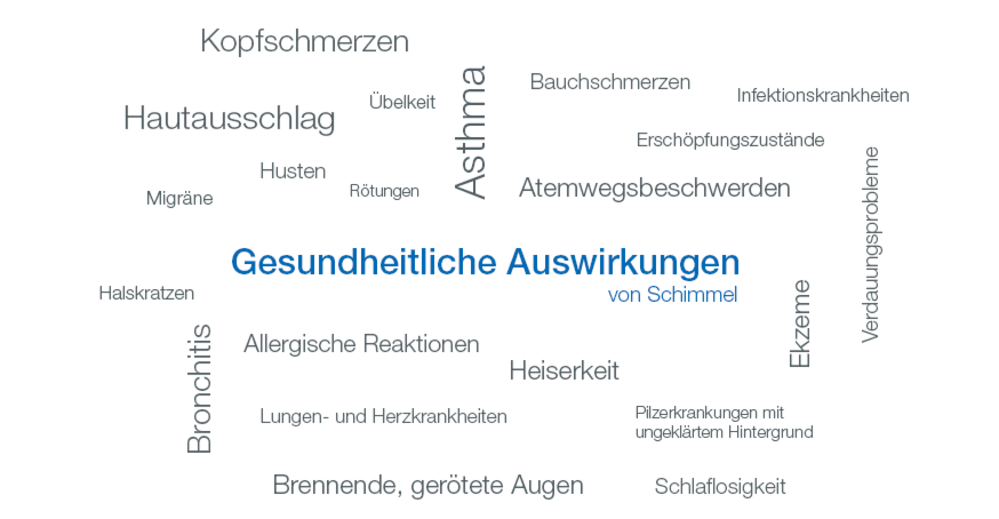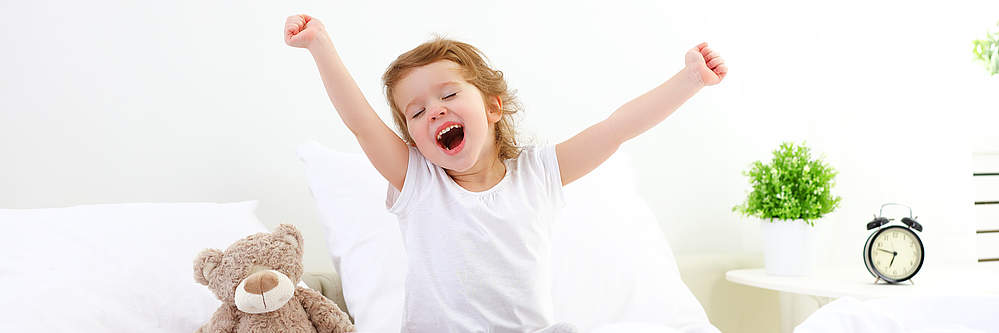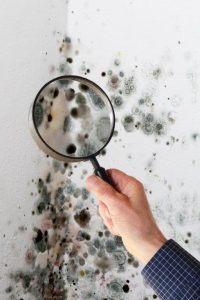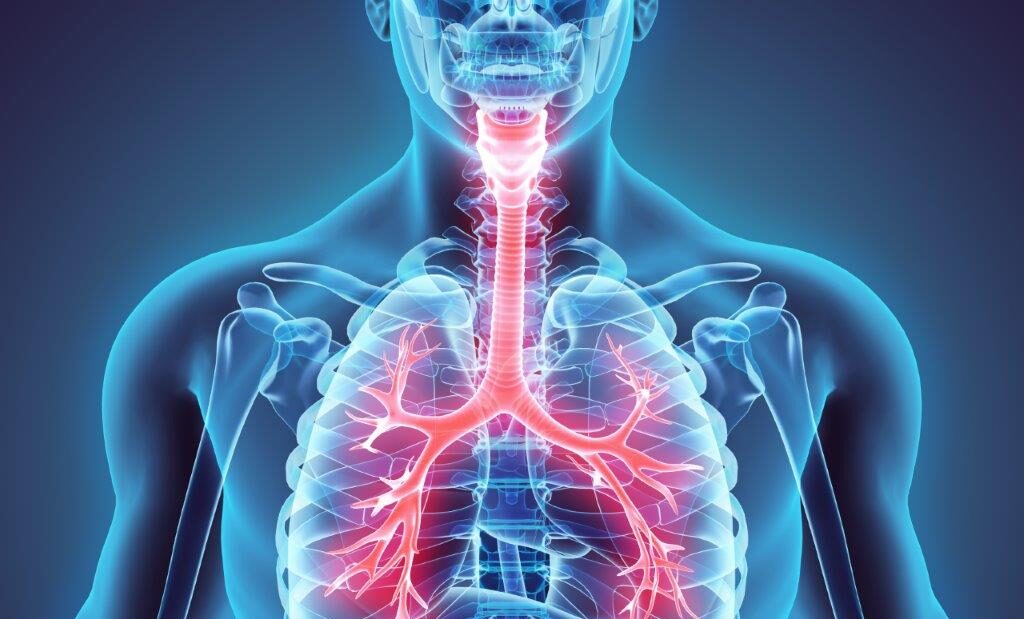Damage to health from mold
Visible and invisible mold can cause significant and sometimes permanent diseases. These range from irritation to allergies and infections. The first symptoms such as headaches or insomnia are not always clear and in some cases it is a long way for those affected to get the correct diagnosis and treatment.
Whether mold spores pose a health risk in the house depends on their concentration and the type of mold. Smaller amounts of mold spores can also get into the room via the outside air, but these low concentrations are generally harmless as they leave the room quickly with proper ventilation. If walls, ceilings, floors or furnishings in living spaces are affected by mold, the concentration of mold spores in the room air increases (evidence of mold spores). In this case, regular ventilation usually no longer helps to remove the mold, but only professional renovation.

The health effects of mold at a glance

- There are many signs of damage to health caused by mold: from irritation of the respiratory tract and allergies to problems with digestion, headaches and fatigue to skin rashes and fungal infections
- These symptoms also occur in other diseases, which is why damage to health caused by mold is difficult to diagnose
- Infants, children and people with weakened immune systems are particularly endangered by mold
- Mold allergies are usually caused by inhaling mold spores in the house with constant mold exposure and manifest themselves in asthma and symptoms that are similar to those of hay fever
- Mold spores can also be found in concentrations that are hazardous to health in indoor air when no obvious mold infestation can (yet) be recognized
- Mold poisoning, which is triggered by special types of mold (e.g. black mold), can cause concentration disorders and fatigue as well as various serious illnesses
Health hazards from mold in the home
How dangerous is mold?
In some cases, mold in living spaces and the building fabric remains undetected for a long time, but the mold spores are already in the room air. The spores, which form dangerous enzymes, enter the human body through respiration and the skin. Mold pollution in living spaces, such as black mold, are generally hazardous to health, but to varying degrees (evidence of mold spores). The toxins formed, so-called mycotoxins, can trigger a variety of diseases. Most of them are respiratory problems or allergic reactions, but some types of mold are suspected of causing cancer or can lead to severe organ damage or even death (including black mold).
People often live in moldy apartments for years. Occurring symptoms are often not associated with the mold and ascribed to other diseases or even ignored. If doctors cannot find a definite cause for the symptoms and discomfort, the patient should be tested for mold as a possible cause of the disease.
The search for the cause of the mold, the removal of the mold and the renovation of the infected components as well as the future avoidance of mold are of particular importance in this context. Health risks can only be minimized and mold-induced diseases that have already occurred can be treated sensibly if the mold load is eliminated in the long term and a renewed load is prevented.

People particularly at risk from mold spores
Especially for people whose immune system is already weakened by a (chronic) previous illness, mold in living spaces is a great danger. Diseases of the cardiovascular system or respiratory diseases, for example, generally make people more susceptible to infections and toxins.
Infants and children can also suffer permanent damage. Children are more sensitive to environmental toxins and have not yet developed sufficient defenses. Your risk of allergies increases if you live in an apartment that is contaminated with mold.

Symptoms and signs of mold spores in indoor air
Certain symptoms can indicate adverse health effects from mold. The problem here is that these signs are usually not clearly attributable to mold, but can also occur in a variety of other diseases. For proof of mold spores in the house, please contact an expert. The symptoms and diseases that can be triggered by mold in the home (mold exposure) include:
- Respiratory problems, allergic reactions, asthma, bronchitis
- Sore throat, hoarseness, cough
- Abdominal pain, nausea, digestive problems
- Headache, migraine
- Exhaustion, tiredness, insomnia
- Burning, reddened eyes
- Rash, eczema, redness
- Fungal diseases with an unexplained background
- Lung and heart diseases
- Infectious diseases
Health problems and diseases caused by mold
People who are exposed to mold over a long period of time can develop chronic allergies, cardiovascular problems or bronchitis. Some types of mold can also cause acute poisoning or certain infectious diseases.
Mold allergy and asthma
Numerous studies have confirmed a connection between exposure to mold and respiratory problems. On the other hand, it has not yet been possible to determine any limit values from which concentration negative health effects can occur. In principle, all molds are able to trigger allergic reactions similar to hay fever with a runny nose, eye irritation and sneezing. Mold allergies can also manifest themselves in migraines, abdominal pain, diarrhea, and vomiting. The most important allergy-causing mold loads are Aspergillus, Cladosporium and Alternaria, which also occur in living spaces.
The most common cause of mold allergies is inhalation of the spores. A damp, moldy home increases the risk of respiratory illnesses and infections, as well as exacerbation of an existing asthma illness. They can occur in seasonal bursts as the amount of spores and fungal threads in the air can change depending on the time of year. A skin test (prick test) can provide information about existing mold allergies.
Mold poisoning
A number of molds are capable of producing very potent toxins. Examples of indoor fungi can be found in the genera Aspergillus or Trichoderma. In addition, there are many other very poisonous types of mold with different distribution that can cause a variety of diseases. A black mold should be mentioned in particular.
The toxins that mold produce are easily dispersed in the air and can cause symptoms of poisoning in people if they are inhaled. Headaches and difficulty concentrating due to mold are often the first signs. It can also lead to severe impaired perception and extreme tiredness.

Some Aspergillus species (including watering can mold, e.g. the black mold Aspergillus niger) are highly toxic to humans. For example, they can affect organs such as the lungs, stomach, intestines and the nervous system. Kidney diseases, peritonitis, inflammation of the inner lining of the heart, pulmonary aspergillosis and other serious diseases can occur.

The cellulose-degrading mold Stachybotrys chartarum, a black mold, can trigger not only the usual allergic complaints and disorders, but also stachybotryosis, which is reminiscent of Alzheimer’s, inflammatory and bleeding lung diseases in infants, cardiac arrhythmias, changes in the white blood count, nosebleeds and even pulmonary bleeding.
Green mold on leftover food

Mold infestation with yellow mold


Advice on suspected damage to health from mold
If you suspect an illness caused by mold, those affected should first speak to their family doctor. If necessary, he or she can call in a specialist to clarify the symptoms. Only a few environmental medicine centers in Germany specialize in advising and treating patients with environmental diseases.
General advice is offered, for example, by the Schimmelpilzberatung Deutschland network and by some health authorities. The local health authorities are also responsible for reporting mold problems in public buildings such as schools and kindergartens.
Conclusion - damage to health from mold
Certain symptoms can indicate a mold-related illness. If the cause of the disease is unclear, doctors and patients should consider this possible reason and clarify it. If mold growth is discovered or suspected in the apartment, the health risks should be taken seriously. A thorough removal of the mold is absolutely necessary. How dangerous mold actually is for your health can only be decided on site.


